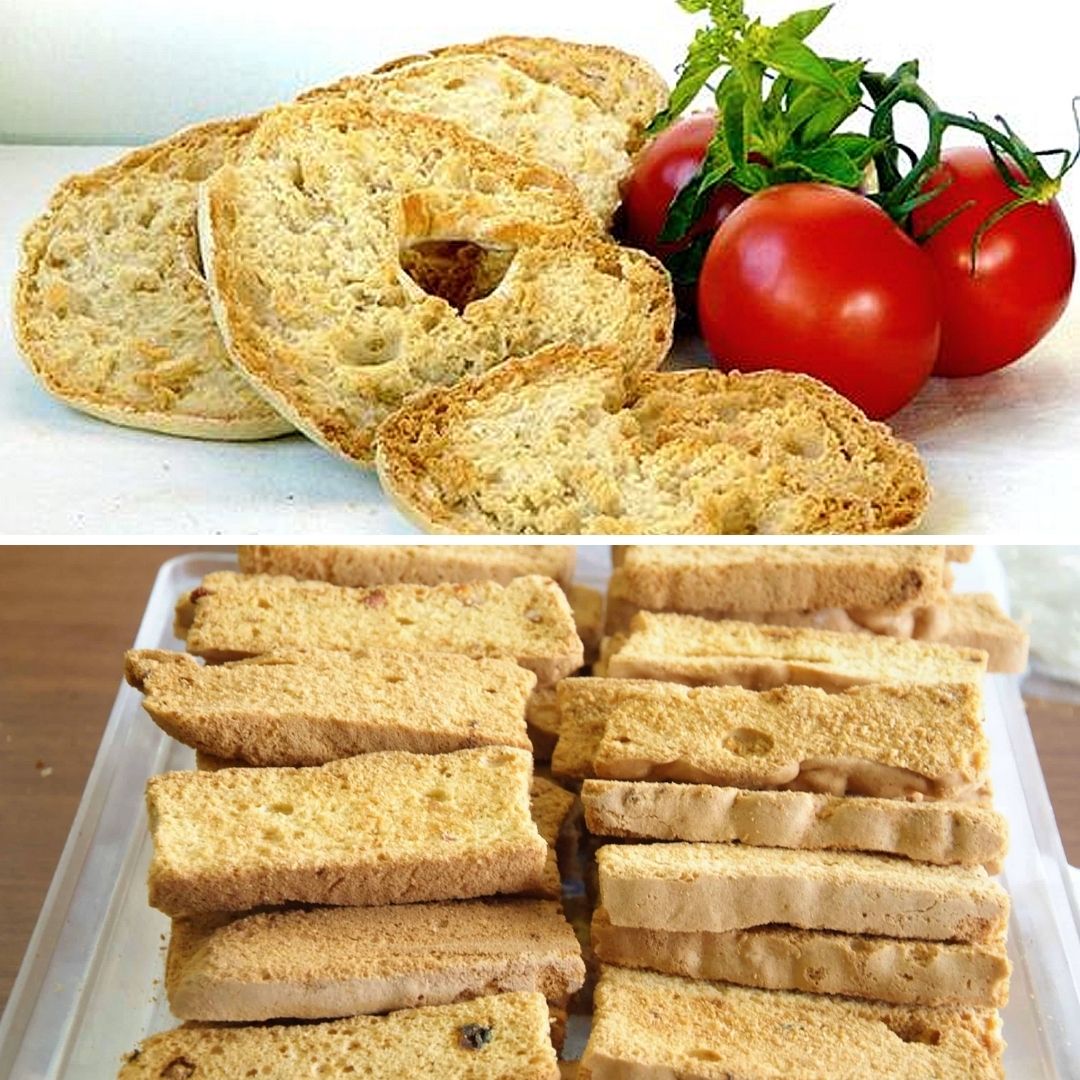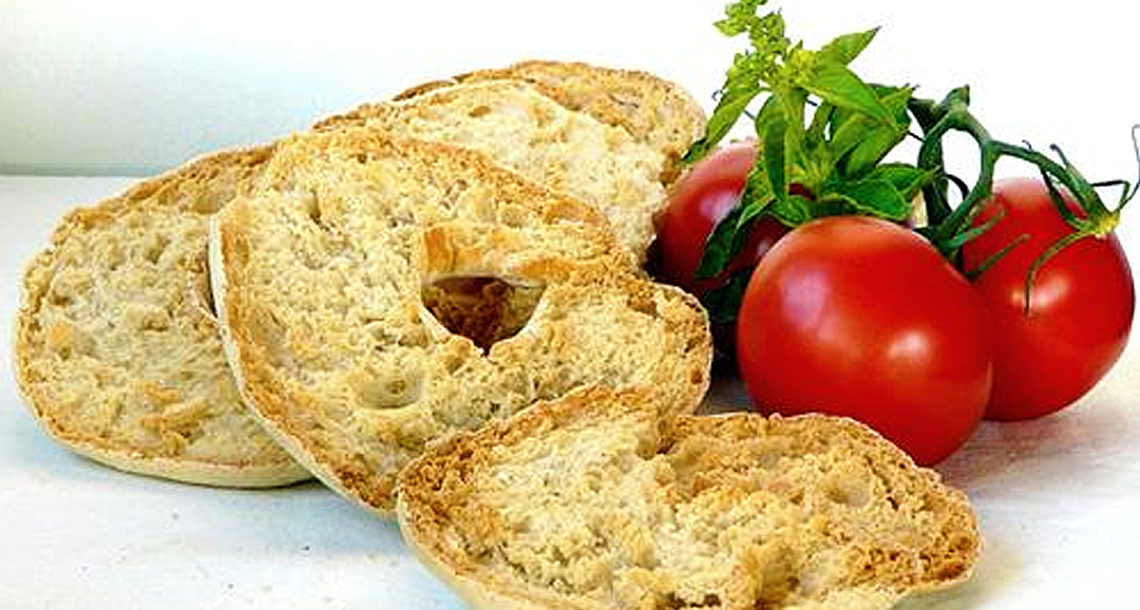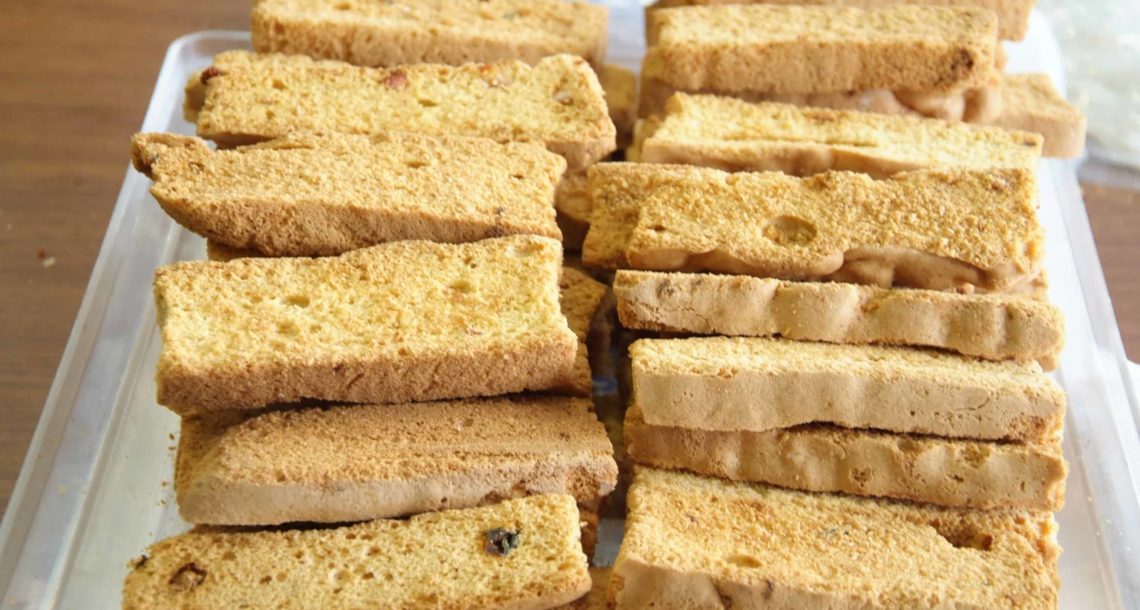Cereals- whole-grain – peksimet vs. frise

Convergenze parallele tra due tipi di pane biscotto: il peksimet turco e le frise pugliesi.
In questo articolo in lingua inglese, firmato da Antonio Caso, esperto di marketing territoriale e da Neşe Ümit Tan, esperto di enogastronomia, emergono le somiglianze tra due pani a lunga conservazione entrambi appartenenti – da regioni diverse – alla Dieta Mediterranea.
In questi tesori dell’agroalimentare mediterraneo, scorgiamo una parte importante di ciò che rende la Dieta Mediterranea così salubre e capace di prevenire numerose malattie.
Cereals, which, along with vegetables and fruit, form the base of the dietary pyramid, hold a special place in the Mediterranean Diet. Rice, maize, barley, spelt, and wheat are all cereal grains. The latter, in particular, is found in all Mediterranean populations since it is used to make pasta, bread, couscous, and bulghur.
Cereals are largely complex carbs, and it’s recommended to eat whole grains rather than refined grains, as the refining process depletes them of vitamins, minerals, and fiber. Whole grains do have a positive impact on health: they lower the risk of cardiovascular disease, diabetes, and cancer, and they aid in weight management and digestive health.
Cereals serve a significant part in the Mediterranean Diet Pyramid, in addition to the daily consumption of fruit and vegetables. But which grains are we talking about? Whole grains are preferred because they have a low glycemic index and include complex carbohydrates, which are essential elements for providing energy to the body. So yes, whole grain bread, pasta, rice, and other grains, as long as they are whole grain, have been unfairly discriminated against by the main low-calorie diets for a long time.
Also, as previously said, the qualities of wholegrain cereals can enhance our health by assisting in the prevention of a variety of ailments. Unfortunately, the exterior sections of whole grains are the most vulnerable to pesticides and pollution from the environment. This is why, if at all feasible, we recommend using organically controlled whole grains.
Cereals, particularly whole grains, are a good source of protein as well as other nutrients including B vitamins, vitamin E, and minerals like magnesium and selenium. They contain a high fiber content, which promotes intestinal transit and lowers the chance of developing intestinal malignancies. Furthermore, contrary to popular opinion, they are low in calories, making them excellent for slimming diets that are often deficient in vitamins and minerals.
Finally, the bran portion of the wheat grain includes phenolic acids, which have a beneficial influence on the “good” intestinal bacteria.
The benefits of eating whole grain cereals with fruit and vegetables in the proper proportions, as suggested by the Mediterranean diet’s food composition, are numerous, as they help to reduce lipid and cholesterol assimilation, lowering the risk of a variety of diseases affecting the cardiovascular, immune, and intestinal systems.
A final point to consider is whether to use flour or grain. Consuming cereals in grains rather than flour is better for a healthy diet, and the semi-integral variety can be deemed just as legitimate for saving time in the kitchen.
What are frise pugliesi?
Simple, flat doughnuts made of dried, dehydrated bread, frise pugliesi are nothing more than a kind of dry bread. But you’ll be pleasantly surprised to taste them after soaking them in water to soften them and seasoning them with the simplest of Mediterranean ingredients: extra virgin olive oil, tomato, and salt.

Origin of Apulian frise
Frise pugliesi are simple, flat doughnuts made of dried, dehydrated bread. They are nothing more than a type of dry bread. After soaking them in water to soften them and seasoning them with the most basic of Mediterranean ingredients: extra virgin olive oil, tomato, and salt, it’s customary to taste them.
The history of frise
According to legend, frise was taken on lengthy sea trips by the faithful who set sail from Salento during the Crusades to reach the Holy Land, because it was excellent for ship transit and long-term storage. As a result, they were known as the crusaders’ bread.
Their dryness made them great sailing food, and they became a mainstay of fishermen’s diets, who seasoned the frise by dipping them directly into the sea. Their doughnut shape with a hole in the middle allowed them to be carried easily in the boat and on journeys by passing a thread through them.
Apulian frise recipe
The biscuit, which makes the frise dry and crispy, and the durum wheat flour are the key ingredients. The dough is formed into a doughnut shape and baked for a few minutes at high temperatures in wood-fired ovens; the loaves are then cut with a thin wire into two discs with a rough, irregular surface while still warm and baked at lower temperatures until they reach the desired crunchiness.
To serve, rinse them briefly under running water, massage them with garlic, and season with extra virgin olive oil and salt. Toss with tomatoes and basil before serving.
Turkish sibling of frise: Peksimet
The Turkish word “peksimet” for rusk comes from Greek – paksamáti or paximadi, it is a twice-baked soldier bread. It is believed that the root of the word paksamáti goes back to the Roman army language notion “buccellatum” from AD 1st century. And if you search the word buccellatum online and take a look at the images, you will see how similar it is to frise at the same time. Once again, the linguistic strings show that there is a cultural loop in food history.
Just like frise was a staple food for naval forces in Puglia; in Anatolia, peksimet was an important food item for the rations as well. The reason was similar, it was easy to keep in a sack and conserve; hard to spoil if made in the right way, and able to supply an adequate amount of nutritional value – just the way the rusk should be.

It is known that especially during the Byzantine Empire’s rule, the barley bread was the most common bread consumed and called paximad. As a result, when it was dried the bread was a darker color and heavy in taste. It is important to point out that instead of using wheat flour – which has a high glycemic index and high content in gluten, barley flour played an important role. Since barley has less gluten content and the lowest glycemic index of all grains, it was more logical to use it in a ration, unlike wheat flour. Nowadays, it is possible to find different types of rusk in Turkey from different flours.
In Turkish Aegean, peksimet is usually made with a chickpea starter. The starter process begins with crushing dried chickpeas and mixing them with a little bit of flour, after that you add tepid water and let it ferment for at least 12 hours or 1 day. This is also known as a “sweet starter” in Turkey as it gives a sweeter aroma to the bread. The chickpea starter gives a different texture and flavor than regular bread yeast. It also increases the shelf-life of the product. It is believed that the Jewish community in İzmir and in Aegean plays a very important role in using chickpea starter in baked goods which are still widely consumed today – including peksimet, İzmir gevreği, and kumru sandwich bread.
How are frise and peksimet connected?
What surprises me the most is that while researching and reflecting on the differences and complicated outcomes of food products through our cultures, Antonio and I still find an immaculate resemblances in a beautiful yet unexpected way. While searching for the types of rusk in Turkey like peksimet, I came upon a dry bread from Siirt called Siirt dry tandoor bread. It is exactly in the shape of frise, consumed in the same way. The production process of this bread is almost the same as frise except the oven type. In this case they use tandır which is a special type of furnace made from a pit in the soil and it is a very common type of cooking/ baking in Southeastern Anatolia.
I expected to see a similar shape in Turkish Aegean, however, I came across an almost identical one, including shape and recipe, in one of the most further regions to a Mediterranean area in Siirt, Turkey. This should give an idea about a diet, a food product, a dish all together; they travel beyond the socially constructed borders and pass through communities. One ingredient can have a significant impact in society even though they represent different languages and geographies . This time we witnessed one from the cereals.
Twice-baked bread – or rusk in other names, is a staple for many different communities all around the world. Even in Turkey and in Italy, there are different names and versions of it other than peksimet and frise. It changes in structure, content, baking method and shape but the essence stays the same: High-quality nutritional value with the least amount of ingredients, easily preservable with a long shelf-life and accessible to all kinds of social levels.
Antonio Caso, Territorial Marketing Expert ; Neşe Ümit Tan, Food and Wine Specialist
